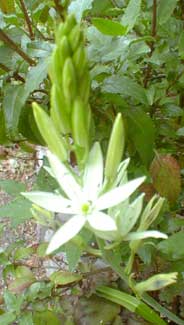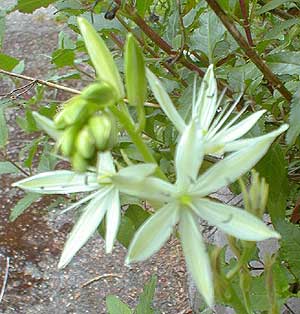
White Great Camas; aka,
Leichtlin's Indian Quamash
"These silver-white stars, shining out from between
Their long-pointed foliage of emerald green."
-Harriet Emma Burton,
1833
1833
Camassia leichtlinii grows two to four feet tall, occasionaly to five feet inclusive of a mature flower spike. Leichtlin's great camas is the most strongly ornamental within the genus. There are color variations including white, cream, purple, or smoky blue, all with yellow anthers. Ours is the white, C. leichtlinii ssp leichtlinii 'Alba.'
 It blooms spring, in May for us, but potentially at any point from late April to June. It has a pyramidal raceme of small bright starflowers atop a tall stem that rises above a tall narrow grassy clump.
It blooms spring, in May for us, but potentially at any point from late April to June. It has a pyramidal raceme of small bright starflowers atop a tall stem that rises above a tall narrow grassy clump.The buds of the raceme open first at the bottom & work their way upward, so the flower lasts nearly a full month. The blooms are widely separated on the raceme so not super-showy, but extremely pleasant. A double-form called 'Semiplena' is much showier.
All camassias are native to North America. This species grows from British Columbia to northern California on the west side of the Cascades & the Sierras, most commonly in mountain meadows.
Edible bulbs were harvested by the First Peoples of the Pacific Northwest, & were semi-cultivated in fields by aboriginal women. They don't make a good harvestable garden vegetable, however, because they reproduce too slowly.
Bulbs are best planted four to six inches deep in autumn, six inches apart, in drifts of a dozen or so. But even a single bulb producing its flower spike above foot-high groundcovers can provide a pleasing sparkle along a garden edge. They can also be grown from seeds, but won't bloom until the third or fourth year. They mix well with Darwin perennial tulips.
When flowers are spent, the strappy grassy clump of leaves will become rather untidy but will soon enough die back in early summer. Don't cut it back prematurely; wait until the leaves start to lose color, to insure the bulb is well-strengthened for the following year.
They'll settle for a little shade (as does ours) but prefer full sun, with rich acidic moderately moist spring followed by dry summer dormancy -- prairie or meadow conditions ideally. It is adaptable to zones 5 through 9, & if it likes where it finds itself growing, it will easily perennialize & perhaps naturalize & spread, requiring very little attention. Once established they should not be disrupted.